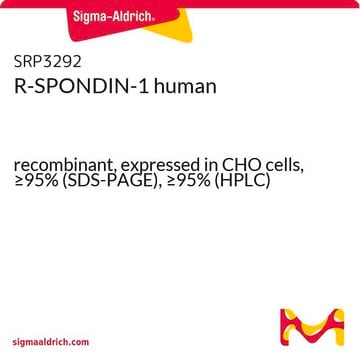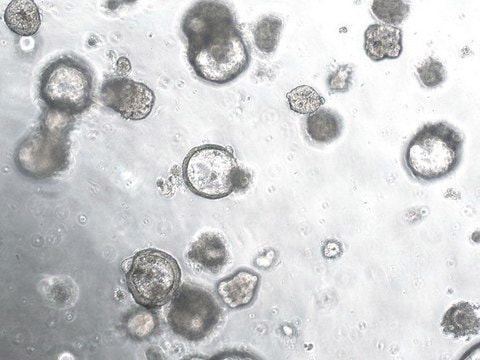SCC111
R-Spondin1 expressing 293T Cell Line
Human
Sinônimo(s):
RSPO1-expressing 293T cells
About This Item
Produtos recomendados
product name
R-Spondin1 expressing 293T Cell Line, The R-Spondin1-Expressing 293T cell line produces RSPO1, a critical protein used to establish 3D organoid cultures from stomach, small intestine, colon, pancreas, and liver sources.
fonte biológica
human
Nível de qualidade
Condições de expedição
ambient
Categorias relacionadas
Descrição geral
The 293T cell line is stably transfected to express mouse R-spondin1 protein tagged with N-terminus HA epitope tag and C-terminus mouse IgG2α Fc region. R-Spondin1 expressing 293T cell line can be used to produce either purified Rspo1 or Rspo1 conditioned media. The FC region and HA tags enable ease of purification and characterization. Cell line is not the published cell line from the Kuo lab, but rather a related cell line developed in the same lab using the reference protocol.
Descrição de linhagem celular
Aplicação
Cell Culture
Qualidade
• Cells are tested negative for HPV-16, HPV-18, Hepatitis A, B, C, Herpesvirus type 6, 7, 8 and HIV-1 & 2 viruses by PCR.
• Cells are negative for mycoplasma contamination.
• Each lot of cells is genotyped by STR analysis to verify the unique identity of the cell line.
Armazenamento e estabilidade
Exoneração de responsabilidade
Código de classe de armazenamento
10 - Combustible liquids
Classe de risco de água (WGK)
WGK 1
Ponto de fulgor (°F)
Not applicable
Ponto de fulgor (°C)
Not applicable
Certificados de análise (COA)
Busque Certificados de análise (COA) digitando o Número do Lote do produto. Os números de lote e remessa podem ser encontrados no rótulo de um produto após a palavra “Lot” ou “Batch”.
Já possui este produto?
Encontre a documentação dos produtos que você adquiriu recentemente na biblioteca de documentos.
Os clientes também visualizaram
Artigos
Organoid culture FAQs. Learn how to culture and analyze organoids following established 3D cell culture protocols. Tips and tricks.
Organoid culture products to generate tissue and stem cell derived 3D brain, intestinal, gut, lung and cancer tumor organoid models.
Nossa equipe de cientistas tem experiência em todas as áreas de pesquisa, incluindo Life Sciences, ciência de materiais, síntese química, cromatografia, química analítica e muitas outras.
Entre em contato com a assistência técnica










